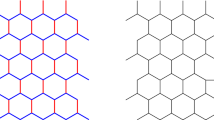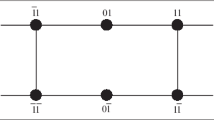Abstract
A graphene nano-ribbon structure can be modelled by a 3-regular hexagonal grid. We convert this to a rectangular coordinate system in order to identify uniquely the position of either the \(\text {V}_2(5-8-5)\) double vacancy (DV) defect or the Stone–Wales SW(55–77) defect. This is done by using the lengths of the closed paths along the edges of the underlying graph. By sending a signal from one of the vertices and detecting the returning impulses one can observe experimentally the spectrum of the structure. Using the trace formula it is possible to determine the lengths of all closed paths (periodic orbits) starting and ending at the given vertex where a detector is placed. We present an algorithm which enables one to pinpoint the precise coordinates of a DV defect by using at most three reference points. Similarly we provide an algorithm for finding an SW defect.





Similar content being viewed by others
References
M. Archibald, S. Currie, M. Nowaczyk, Finding the hole in a wall. Journal of Mathematical Chemistry 58, 2313–2323 (2020). https://doi.org/10.1007/s10910-020-01178-3
F. Banhart, J. Kotakoski, A.V. Krashaninnikov, Structual defects in graphene. American Chemical Society 5(1), 26–41 (2011). https://doi.org/10.1021/nn102598m
M. Manoharan, H. Mizuta, Point defect-induced transport bandgap widening in the downscaled armchair graphene nanoribbon device. Carbon 64, 416–423 (2013). https://doi.org/10.1016/j.carbon.2013.07.094
I. Shtepliuk, R. Yakimova, Interband transitions in closed-shell vacancy containing graphene quantum dots complexed with heavy metals. Physical Chemistry Chemical Physics: PCCP 20, 21528–21543 (2018). https://doi.org/10.1039/C8CP03306D
P. Exner, Contact interactions on graph superlattices. Journal of Physics A: Mathematical and General 29, 87–102 (1996). https://doi.org/10.1088/0305-4470/29/1/011
J. Griffith, A free-electron theory of conjugated molecules I. Polycyclic Hydrocarbons. Transactions of the Faraday Society 49, 345–351 (1953). https://doi.org/10.1039/TF9534900345
B. Gutkin, U. Smilansky, Can one hear the shape of a graph? Journal of Physics A: Mathematical and General 34, 6061–6068 (2001). https://doi.org/10.1088/0305-4470/34/31/301
P. Kuchment, Graph models for waves in thin structures. Waves in Random Media 12, R1–R24 (2002). https://doi.org/10.1088/0959-7174/12/4/201
P. Kurasov, M. Nowaczyk, Inverse spectral problem for quantum graphs. Journal of Physics A: Mathematical and General 38, 4901–4915 (2005). https://doi.org/10.1088/0305-4470/38/22/014
J.C. Meyer, C. Kisielowski, R. Erni, M.D. Rossell, M.F. Crommie, A. Zettl, Direct imaging of lattice atoms and topological defects in graphene membranes. Nano Letters 8(11), 3582–3586 (2008). https://doi.org/10.1021/nl801386m
J. Kotakoski, A.V. Krasheninnikov, U. Kaiser, J.C. Meyer, From point defects in graphene to two-dimensional amorphous carbon. Physical Review Letters 106(10), 105505 (2011)
K. Pankrashkin, Spectra of Schrödinger operators on equilateral quantum graphs. Letters in Mathematical Physics 77, 139–154 (2006). https://doi.org/10.1007/s11005-006-0088-0
Author information
Authors and Affiliations
Corresponding author
Additional information
Publisher's Note
Springer Nature remains neutral with regard to jurisdictional claims in published maps and institutional affiliations.
M. Archibald: National Research Foundation Grant Number 89147
S. Currie: National Research Foundation Grant Number 103530.
Rights and permissions
About this article
Cite this article
Archibald, M., Currie, S. & Nowaczyk, M. Locating a double vacancy or Stone–Wales point defect on a hexagonal quantum grid. J Math Chem 60, 862–873 (2022). https://doi.org/10.1007/s10910-022-01337-8
Received:
Accepted:
Published:
Issue Date:
DOI: https://doi.org/10.1007/s10910-022-01337-8




